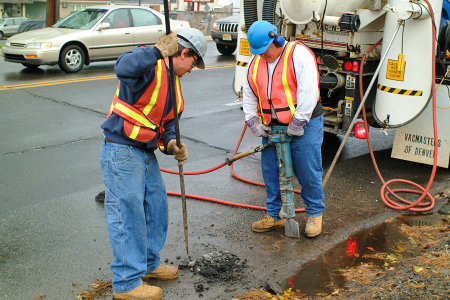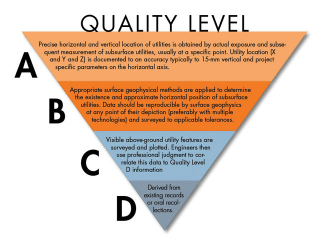It is so easy to make a catastrophic mistake when dealing with utilities and sub-ground systems. Navigating the labyrinth of underground utilities presents a significant challenge to even the most experienced industrial workers. The risk of accidental damage to essential infrastructure not only poses safety concerns but also leads to costly project delays and environmental hazards. Subsurface Utility Engineering or “SUE” standards, developed by the American Society of Civil Engineers, are a process to manage risks associated with utility coordination of more than 100 billion feet of buried utilities across the United States. To achieve the most precise utility information, test holing to expose the horizontal and vertical location of utilities must be performed using minimally intrusive excavation to minimize the potential for utility damage. At Haaker Underground, we understand this challenge and are ready to meet it with our equipment offerings. Addressing these challenges requires adherence to rigorous standards and innovative technologies that mitigate risks effectively.
Subsurface Utility Engineering (SUE) Standards
Developed by the American Society of Civil Engineers (ASCE), SUE standards provide a structured approach to managing the complexities of subsurface utilities across the United States. The ASCE’s publication “Investigating and Documenting Existing Utilities, ASCE/UESI/CI 38-22” outlines SUE as a comprehensive process rather than a singular technology. It encompasses activities such as utility mapping, coordination, relocation design, and condition assessment, all crucial for minimizing risks associated with utility infrastructure.
This publication makes it very clear that SUE is a process, not a technology. It describes SUE as a branch of engineering practice that involves managing certain risks associated with: utility mapping at appropriate quality levels, utility coordination, utility relocation design and coordination, utility condition assessment, communication of utility data to concerned parties, utility relocation cost estimates, implementation of utility accommodation policies, and utility design. These activities, combined with traditional records research and site surveys, and utilizing new technologies such as surface geophysical methods and non-destructive vacuum excavation, provide “quality levels” of information.
The overall SUE process involves determining the scope of work, designating surface markers, locating horizontal & vertical utilities, data management, and conflict matrix analysis. The implementation of SUE offers several critical advantages including risk mitigation, cost efficiency, and enhanced safety. By accurately mapping utilities at different quality levels (Quality Level A to D), SUE reduces the likelihood of costly surprises during construction, such as unexpected utility conflicts or damage. Early identification and precise mapping of utilities allow project designs to account for existing infrastructure, minimizing the need for expensive relocations or redesigns. By using non-destructive methods like vacuum excavation, SUE ensures that excavation work is performed with minimal risk to utility integrity and surrounding environment, thereby enhancing overall safety on construction sites.

Project Development
SUE is particularly crucial for projects involving significant excavation or horizontal construction under public contracts. Projects meeting specific criteria, such as depth of excavation or utility boring, necessitate the involvement of licensed SUE professionals to manage utility risks effectively. ASCE’s guidelines, particularly Standard Guideline for the Collection and Depiction of Existing Subsurface Utility Data (CI/ASCE 38-02), define the quality levels required for utility data collection, ensuring consistency and reliability across projects.
SUE projects must meet the following requirements. The project must have a construction contract with a public entity. The project involves primarily horizontal construction. The project has an anticipated excavation footprint that exceeds two feet in depth and that is a contiguous one thousand square feet or involves utility boring. And finally, the project requires the services of a licensed professional engineer. On larger, more complex projects, companies or agencies may elect to employ the services of a SUE provider to obtain expert advice and to use available technologies to provide better information.
The SUE engineer, when involved, will advise of utility risks and recommend an appropriate quality level of utility data as described above for a given project area at the appropriate time within the project planning and design process. The agency will then specify to the engineer the desired quality level of utility data. The engineer will furnish the desired utility quality level to the highway agency in accordance with the standard of care and will be responsible for negligent errors and/or omissions in the utility data for the certified utility quality level.

TRUVAC Paradigm
At the heart of Haaker Underground’s commitment to SUE standards lies the TRUVAC Paradigm, an innovative vacuum excavation truck tailored to meet the most stringent safety and efficiency requirements. When equipped with the optional Air Excavation package, the TRUVAC Paradigm digs potholes and backfills immediately with the vacuum-excavated dirt. If air excavation isn’t for you, TRUVAC offers a selection of hydro excavation products to meet SUE’s highest standards and safely excavate. However, if possible to use the Paradigm, this compact yet powerful equipment enables precise excavation around utilities without compromising their integrity. Whether using hydro excavation or air excavation methods, the TRUVAC Paradigm ensures minimal disturbance to the ground. The TRUVAC Paradigm uses non-destructive vacuum excavation and therefore meets the highest Quality Level A (QL-A) demanded by Subsurface Utility Engineering (SUE) providers.
Navigating the complexities of underground utilities demands a combination of expertise, adherence to standards, and advanced technologies. Haaker Underground’s dedication to meeting the highest quality and safety standards, including SUE principles exemplifies our proactive approach to utility management. By leveraging the solutions like the TRUVAC Paradigm, construction projects can proceed with confidence, knowing that risks are minimized, safety is enhanced, and operational efficiencies are maximized.
For more information on how Haaker Underground and the TRUVAC Paradigm can enhance the safety and efficiency of your construction projects, contact us today at (909) 598-2706 or message us directly here. Ensure your project meets the highest SUE standards with our innovative solutions today.
